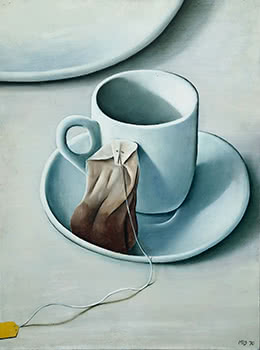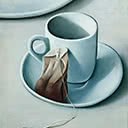Teacup
60.5 x 45 cm
est. $45,000 - 65,000
PROVENANCE Private Collection, Taranaki Purchased directly from the artist, 1970
From the early 1960s when Michael Smither and his poet wife Elizabeth went to live in the Gables in New Plymouth, a recurring subject for his painting was domestic family life as he coped with the onslaught of three children. It was a period celebrated by Auckland Art Gallery curator, the late Ron Brownson (1952-2023) in his exhibition The Wonder Years in 2005. A hiatus from childcare came in 1970 when the Smithers moved to Dunedin where Michael was the Frances Hodgkins Fellow at the University of Otago for a year. The white institutional teacup featured in this composition, with its used Lipton's teabag resting on it, seeming to push it slightly off centre on its saucer, symbolises a moment of pause and respite from the hurly burly of daily life.
The composition has a kind of sacramental simplicity, acting as a reminder of Smither's Catholic upbringing. The steeply raked picture plane tips the perfect circle of the top of the teacup towards us so we can stare into its emptiness like a eucharistic chalice. The dark shadow across its interior seems portentous as does the matching white dinner plate which curves in from the top of the composition. The cool light of day illuminates the painting, casting shadows from above and enlivening the string of the teabag which snakes from the top of the spent bag across the foreground toward the viewer like the fuse to an explosive.
As a still life composition, this is an exercise conducted almost entirely in monochromatic blue- grey and white with just a glimpse of the teabag label cut off at left. It seems very avant-garde compared to the complementary colours of orange and green which characterised the conventional apples and pears of the early modernist painters such as Paul Cézanne (1839-1906) and the Cubists.
During this period, rather than looking to the French masters, Smither strove for English painter Stanley Spencer's (1891-1959) simplification of form. He also followed Spencer's precedent of putting religious subjects into ordinary contexts by depicting the life of Christ as if lived in the Taranaki landscape. As Smither once said of his early Catholicism, I don't think it did me any harm...It gave me a sense of the spiritual in life. This humble teacup takes on a spiritual quality here as Smither shows us the beauty to be found in simplicity.
Teacup might also be seen as a celebration of kiwiana and the rituals of daily life. The 1960s and 1970s were the heyday of Crown Lynn Potteries, the largest ceramic manufacturer in the Southern Hemisphere with a staff of 450, producing 240,000 pieces a week. Recognisable here are the forms of its classic dinnerware productions. As a New Zealander gazing at this work, you can almost feel the shiny glaze of the vitrified crockery cup as it would feel against a finger inserted in the handle.
Ultimately though, beyond its symbolic possibilities, this composition shows Smither's ability to arrange recognisable objects to make an abstract pattern of chiming geometries, and his skill at balancing colour, light and texture.
LINDA TYLER





